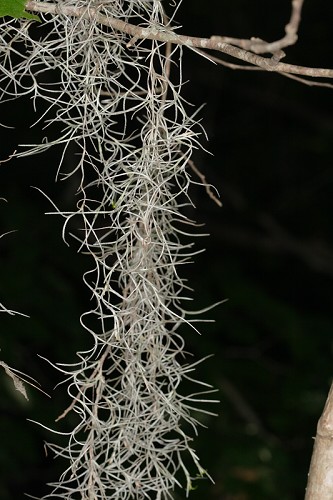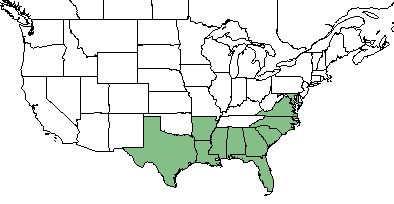Difference between revisions of "Tillandsia usneoides"
| Line 23: | Line 23: | ||
==Description== <!-- Basic life history facts such as annual/perrenial, monoecious/dioecious, root morphology, seed type, etc. --> | ==Description== <!-- Basic life history facts such as annual/perrenial, monoecious/dioecious, root morphology, seed type, etc. --> | ||
| − | ''Tillandsia usneoides'' is an epiphyte<ref name="Ladybird">Plant database: ‘’Tillandsia usneoides’’. (11 January 2018).Lady Bird Johnson Wildflower Center. URL: https://www.wildflower.org/plants/result.php?id_plant=TIUS</ref> that typically is found hanging from the branches of trees.<ref name="Weakley 2015"/> It is classified as a monoecious perennial that grows as a forb/herb or vine.<ref name="USDA"/> | + | ''Tillandsia usneoides'' is an epiphyte<ref name="Ladybird">Plant database: ‘’Tillandsia usneoides’’. (11 January 2018).Lady Bird Johnson Wildflower Center. URL: https://www.wildflower.org/plants/result.php?id_plant=TIUS</ref> that typically is found hanging from the branches of trees.<ref name="Weakley 2015"/> It is classified as a monoecious perennial that grows as a forb/herb or vine.<ref name="USDA"/> Leaves are whitish gray in color and its flowers are white solitary inconspicuous flowers which occur at the end of short axillary branches.<ref name="Ladybird"/> |
==Distribution== | ==Distribution== | ||
Revision as of 12:45, 11 January 2018
| Tillandsia usneoides | |
|---|---|

| |
| Photo by John Gwaltney hosted at Southeastern Flora.com | |
| Scientific classification | |
| Kingdom: | Plantae |
| Division: | Magnoliophyta - Flowering plants |
| Class: | Liliopsida - Moncots |
| Order: | Bromeliales |
| Family: | Bromeliaceae |
| Genus: | Tillandsia |
| Species: | T. usneoides |
| Binomial name | |
| Tillandsia usneoides L. | |

| |
| Natural range of Tillandsia usneoides from USDA NRCS Plants Database. | |
Common Name(s): Spanish-moss[1][2]
Contents
Taxonomic Notes
Synonym(s): Dendropogon usneoides[2]
Description
Tillandsia usneoides is an epiphyte[3] that typically is found hanging from the branches of trees.[1] It is classified as a monoecious perennial that grows as a forb/herb or vine.[2] Leaves are whitish gray in color and its flowers are white solitary inconspicuous flowers which occur at the end of short axillary branches.[3]
Distribution
This species is found along the coastal plain in eastern Texas, eastward to Florida, and northward Maryland. It also occurs in parts of Mexico, Central and South America, the West Indies.[1][2]
Ecology
Habitat
T. usneoides requires areas with high humidity and is therefore common in swamps.[1] It can also be found in dry forests, including sandhills, where frequent fog occurs.[1]
Phenology
Flowering occurs from March through June[1][4] and may also occur in the winter from September through December.[4]
Conservation and Management
Cultivation and restoration
Photo Gallery
References and notes
- ↑ 1.0 1.1 1.2 1.3 1.4 1.5 Weakley A. S.(2015). Flora of the Southern and Mid-Atlantic States. Chapel Hill, NC: University of North Carolina Herbarium.
- ↑ 2.0 2.1 2.2 2.3 USDA, NRCS. (2016). The PLANTS Database (http://plants.usda.gov, 11 January 2018). National Plant Data Team, Greensboro, NC 27401-4901 USA.
- ↑ 3.0 3.1 Plant database: ‘’Tillandsia usneoides’’. (11 January 2018).Lady Bird Johnson Wildflower Center. URL: https://www.wildflower.org/plants/result.php?id_plant=TIUS
- ↑ 4.0 4.1 Nelson G. (11 January 2018) PanFlora. Retrieved from gilnelson.com/PanFlora/